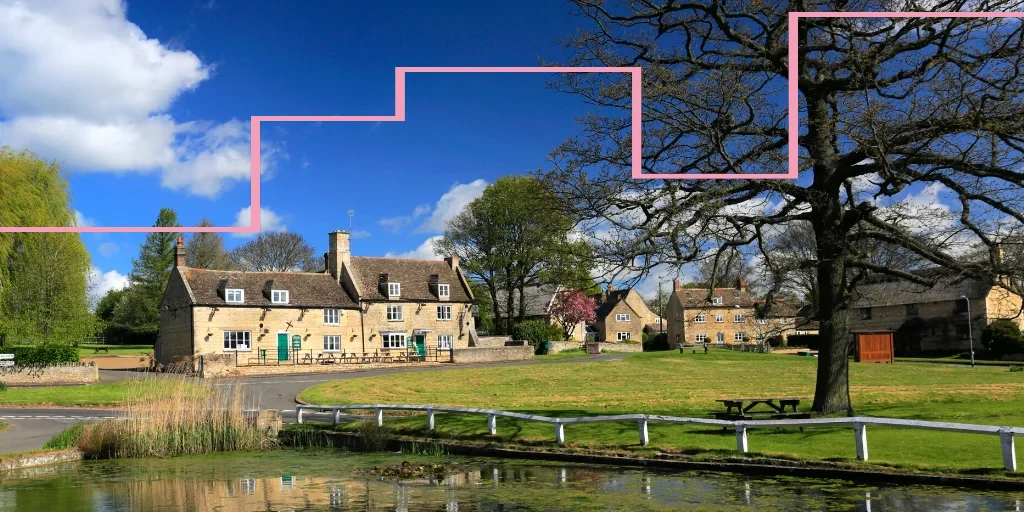With several cases relating to village greens reaching the supreme court in the last 20 years, Michael Orlik, consultant at Lodders and specialist in highways and rights of way, highlights some recent cases and their implications.
In February 2021, the Supreme Court upheld the lower courts’ decision, to refuse an application to remove from the register of town or village greens an area of concrete by the water’s edge, in a working port known as Allen’s Quay.
This was the fourth village greens case to reach the highest court within the last 20 years. Why this expenditure of time and money on village greens? How can a concrete quay possibly be a village green – and does its registration make any difference to the activities on it?
Registration as a village green
The explanation goes back to the Commons Registration Act 1965. Under the Act, local authorities were required to prepare registers of common land, including town and village greens. The definition of a town or village green was:
“land… allotted by or under any Act for the exercise or recreation of the inhabitants of any locality or on which the inhabitants of any locality have a customary right to indulge in lawful sports and pastimes or on which the inhabitants of any locality have indulged in such sports and pastimes as of right for not less than 20 years”.
The Act did not define a village green as a piece of open grass surrounded by houses, a shop and a pub, maintained for the purpose of playing gentle sports. Traditional village greens fitting that description were registered without problem between 1967 and 1970, the period allowed for registration.
Soon after, in cases disputed before the Commons Commissioners, it became apparent land, which was neither green nor in the centre of a built-up area, could also fall within the Act’s ‘village green’ definition. A Commons Commissioner upheld the registration as a village green of an area of rocks on the Anglesey seashore, to which boats had been tied for the purpose of boating.
In R v Oxfordshire County Council Ex p Sunningwell Parish Council [2000] AC 335, the House of Lords considered issues relating to a meadow on the outskirts of a village, which had been glebe land belonging to the rector. It had been used for solitary or family pastimes – but not for organised sport. Hoffman LJ said dog walking and playing with children were a kind of informal recreation which may be the main function of a village green.
In Oxfordshire County Council v Oxford City Council [2006] UKHL 25, the House of Lords considered nine acres of scrubland on the outskirts of Oxford. Known as ‘the Trap Grounds’, it was paths and scrubland which even ‘the hardiest walker’ would find it difficult. Nevertheless, the public had walked there for many years, and the House of Lords held it could be registered as a village green. Oxford City Council had hoped to build houses on it.
Victorian statutes
Local residents realised registration was effective in preventing new development, because of the protection afforded by two historic statutes.
Section 12 of the Inclosure Act 1857 states,“… it is expedient to provide summary means of preventing nuisances in town greens and village greens” and further makes it an offence to damage any fence on a village green, to drive cattle on it, to lay rubbish on it, or, to:
“do any other act whatsoever to the injury of such town or village green or land, or to the interruption of the use or enjoyment thereof as a place for exercise and recreation”.
Section 29 of the Commons Act 1876 provides:
“An encroachment on or inclosure of a town or village green, also any erection thereon or disturbance or interference with or occupation of the soil thereof which is made otherwise than with a view to the better enjoyment of such town or village green or recreation ground, shall be deemed to be a public nuisance”.
This potentially renders offenders liable to a fine.
There are areas of land on the outskirts of villages where landowners have given up the struggle to keep trespassers out, and have allowed locals to walk, exercise dogs or pick blackberries. Some such land is owned by developers, content to allow informal use, awaiting land release in the next development plan.
Landowners have found, to their cost, their indulgence of such activities, and failure to make it clear such use was by permission, rather than as of right, has resulted in the loss of the otherwise huge development value of the land.
Restrictions of ‘village green’ status
In 2013, parliament addressed this issue in section 16 of the Growth and Infrastructure Act 2013. Under that section, the right to apply to register land as a town or village green ceases to apply if a “trigger event” occurs. Trigger events were set out in Schedule 4 by way of a new Schedule 1(A) to section 15 of the Commons Act 2006. Trigger events include an application for planning permission or the creation or adoption of a development plan.
Applications to register village greens are made under section 15 of the Commons Act 2006. The Growth and Infrastructure Act 2013 added a new section 15A to that Act, providing landowners can, at any time, lodge a statement with the local authority to conclude any ‘as of right’ lawful sports and pastimes on land shown in an accompanying plan. Such statements must be renewed every 20 years.
During the intervening period, use by the inhabitants of the land for recreation could not be counted in a village green registration application. Even if the landowner was not taking precautions to keep the public away, he would be able to defeat an application to register.
A notice that a statement has been lodged must be placed on-site, but there is no other requirement for public advertisement. However, amenity bodies, such as the Open Spaces Society, and local residents can give notice to registration authorities that they wish to be informed of any such statements.
If a landowner statement is lodged interested persons can, within one year, make an application to register the land as a village green based on 20 or more years of use as of right by the public prior to the statement date. Rather than risk it, a landowner might decide to take precautions against allowing the public onto his land – even though this requires effort.
Co-existence
In R (Lewis) v Redcar and Cleveland Borough Council (No. 2) [2009] EWCA Civ 3, a successful application had been made by local residents to register the golf course as a village green. The Supreme Court held they could co-exist. Kerr LJ said:
“… where it is feasible, cooperative, mutually respecting uses will endure after the registration… Where the lands have been used by both the inhabitants and the owner over the pre-registration period, the breadth of the historical use will be, if not exactly equivalent to, at least approximate to that which will accrue after registration”.
As to whether different uses could be carried on, Walker LJ pointed out the local council could make byelaws for village greens, and continued:
“Even without such regulation, conflicts over competing uses… are capable of resolution by the “constant refrain in the law of easements that ‘between neighbours, there must be give as well as take’”.
TW Logistics v Essex County Council [2021] 2 WLR 383
Allen’s Quay is located in a port on the River Stour, Essex, operated by TW Logistics Limited (the company), and much of the land is owned by the company.
The public walks freely on the quay and harbour. After a lengthy inquiry, an inspector recommended the land should be registered as a village green, and Essex County Council accepted his recommendation. The company asked the High Court to quash the registration; neither the High Court nor the Court of Appeal would, so the case reached the Supreme Court.
The court held, once the land was registered as a village green, it could be used for any recreational activity, even if it had been registered on the basis of informal activities such as walking. However, the court also held, although recreational activities could take place, account had to be taken of the way in which the land had been used by the owner and by the public in the 20-year qualifying period prior to registration. Sales LJ and Burrows LJ, said:
“… the exercise of that right is subject to the ‘give and take’ principle, so it is potentially misleading to think that there is a ‘one size fits all’ principle. This means that the public must use their recreational rights in a reasonable manner, having regard to the interests of the landowner (which may, or may not, be commercial) as recognised in the practical arrangements which developed to allow for co-existing use of the land in question during the qualifying period. The standard of reasonableness is determined by what was required of local inhabitants to allow the landowner to carry on his regular activities around which the local inhabitants were accustomed to mould their recreational activities”.
Their Lordships added:
“The landowner also has the right to undertake new and different activities provided they do not interfere with the rights of the public to use the land for lawful sports and pastimes.”
After proceedings, the company are in much the same position as they were before Allen’s Quay was successfully registered as a village green. They can continue to use the land for commercial activities and drive vehicles over it. The only difference is that the status of the land as a village green is protected so it can never be built on. This might have some relevance to redevelopment, but this was not the reason for litigation. They were worried the Victorian statutes would prevent them from continuing their commercial activities on the land.
The Supreme Court held the terminology used in the Victorian legislation showed it was directed at public nuisances. Activities “warranted by law” could not be public nuisances. It was not a nuisance for the landowner to continue what he had been doing previously on his land. The company’s proprietary rights were sufficiently clear to be recognised in the operation of the Victorian statutes. It was not behaving unlawfully in continuing its pre-registration activities.
One motivator for the registration application was action taken by the Health and Safety Executive (HSE) requiring the company to erect fencing along the edge of the quay to prevent any employee or member of the public from falling in the harbour. The Supreme Court addressed this by saying any HSE requirement to safeguard employees or the public would be “warranted by law” and would not contravene statute.
Access drives to houses
The company were exercising normal acts of ownership. A different situation exists in the traditional village green. Many village greens are vested in the local parish council, and problems arise when newcomers buy properties around the green. The new owner’s use of any drive over the green may be challenged. The purchaser’s solicitor needs to ensure the vendor and predecessors in title have used any drive over the village green for the previous 20 years. If previous access has been on foot only, the parish council may be able to stop the construction of a drive. If the new owner wants to put a hard surface on the drive or widen it, they may again encounter resistance. Section 12 of the Enclosure Act 1857 provides a fine may be payable:
“…if any person…wilfully lay any manure, soil, ashes or rubbish, or other matter or thing thereon, or do any other act whatsoever to the injury of such town or village green or land, or to the interruption of the use or enjoyment thereof as a place for exercise and recreation…”.
Laying a hard surface is not akin to depositing rubbish but it is putting “other matter” on the surface of the green. In Massey v Boulden [2003] 1 WLR 1793, Longmore LJ commented:
“I see no sufficient reason to regard the existence and use of the track as injuring the green or interrupting its use or enjoyment by others.”
That remark would certainly cover existing use, but not necessarily an improvement to the drive over the green. These are sensitive matters in village communities.
If any highway verge has been registered as part of the village green, the status of the drives over the verge can be brought into question. Sometimes, verges between the highway and houses are maintained by the highway authority and are shown as part of the highway under section 36 of the Highways Act 1980. It is worth checking this list if disputes arise; land may be both. If the grass is part of the highway, there will not a problem – as a frontager to the highway has the right to access it from his property.
Protecting potential
TW Logistics has put to rest anxieties that registrations of village greens will bring an end to pre-registration activities. However, problems of future development remain. If owners are allowing land to be used for informal recreation, they need to make a conscious decision as to whether they are happy for the land to be registered as a village green, or whether they wish to lodge a statement to stop time; or to take other steps, such as excluding the public, or erecting notices that use is permissive, replacing them at least annually if they disappear.
This article first appeared on The Solicitors Journal.
Contact usCONTACT US
Need more advice?
For help with a legal problem or more information on any of our services at Lodders, please get in touch with our friendly team. You can contact us via the number or email address below, or fill in the form and we will get back to you as quickly as we can.

Read more
Other news, insights and events








